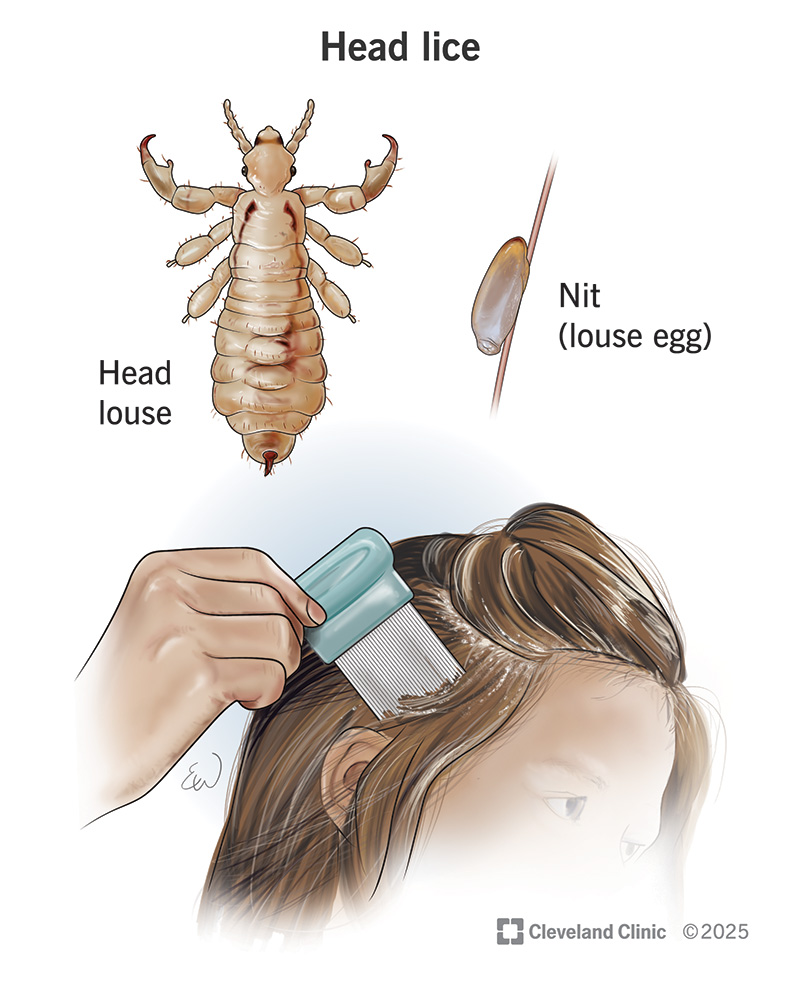Head lice are tiny, crawling insects that live in the hair on your head. They lay eggs and bite your scalp, making it itchy. Lice are most common in younger or school-aged kids. Lice are treatable with special shampoos, creams or lotions. Talk to a healthcare provider if you’re having a hard time getting rid of lice.
Advertisement
Cleveland Clinic is a non-profit academic medical center. Advertising on our site helps support our mission. We do not endorse non-Cleveland Clinic products or services. Policy

Head lice are tiny, parasitic insects that can live in your hair. They bite your skin to suck your blood and attach their eggs (called nits) to your hair, close to your scalp. All this can make your head itchy.
Advertisement
Cleveland Clinic is a non-profit academic medical center. Advertising on our site helps support our mission. We do not endorse non-Cleveland Clinic products or services. Policy
Head lice are most common in young kids. But don’t worry; head lice have nothing to do with your kids’ hygiene. Like germs, they just spread more easily in people who spend a lot of time close together.
While most of us just think of them as “bugs,” you might hear an infestation of head lice called pediculosis.
Symptoms of head lice include:
Adult lice are gray or tan with three pairs of legs that look like claws. They’re smaller than a sesame seed. As lice move quickly, you’re more likely to find eggs than lice themselves.
Head lice eggs are white, yellowish, tan or brown. You can find them close to your scalp. They’re tiny and might look like dandruff, but they don’t come off easily if you pull on them. You can use a nit comb and conditioner to pull them out.
Head lice usually spread from person to person by direct contact. But they may also spread by sharing items that touch your head (like combs, brushes and hats). Lice are most common in kids ages 3 to 12, as they’re usually in frequent, close contact with each other.
Lice don’t have wings, but they’ll crawl between people and live in warm areas of your body, like on your head. Adult lice lay eggs near your scalp and glue them to your hair. Five to 10 days later, the lice hatch. Over the next nine to 12 days, they’ll bite you several times to take a meal. They’ll grow into adults and lay more eggs, starting the cycle over again.
Advertisement
Head lice are mostly harmless and don’t carry diseases. But the itching might make your child scratch their head a lot. This can break the skin and lead to bacterial infections.
You can check for lice by running a fine-toothed comb or a special head lice comb slowly through your child’s wet hair. Inspect the comb for lice and their eggs after each time you pull it through. Lice are most commonly found at the back of your head and neck, and near your ears.
If you think your child might have lice but you can’t confirm it, ask their healthcare provider or school nurse for help.
The best way to treat lice is with an over-the-counter or prescription shampoo, lotion or cream that kills them. Follow the directions on how to apply it and how often to use it. Note that some treatments shouldn’t be used on babies.
Talk to your child’s healthcare provider if you’re unsure which is best to use or if the first treatment you try isn’t working. Lice are becoming resistant to treatment. It may take a combination of treatments to get rid of them completely.
Some lice treatment options include:
Another technique is to apply hand lotion or conditioner to your child’s wet hair for two minutes, then comb the lotion or conditioner out with a fine-toothed comb. Repeat every few days for two to three weeks after you last saw a live louse. These and other home remedies might work best when combined with medicated shampoo, cream or lotion treatment.
Get rid of lice on clothing, bedding and personal items by:
Call your child’s healthcare provider if treatments aren’t working or if your child has signs of an infection. These include:
With effective treatment, head lice can go away after two to three weeks. Sometimes, you might have to try a different kind of treatment if the first doesn’t work.
Advertisement
If your child can’t stop scratching, contact their healthcare provider. They might be able to give you additional treatment options to prevent them from damaging their scalp.
Kids usually don’t have to stay home from school if they have head lice. But it’s important to tell their school, daycare or babysitter about it. Remind your child to avoid making head-to-head contact with other kids during playtime. The school may let other parents know so that they can check and treat their kids.
You and your child can prevent spreading lice by:
Adult head lice can live without a host for only a day or two. Eggs can survive about 10 days.
Yes. While head lice don’t live long, they can spread from person to person if you share a pillow.
They’re crawly. They’re itchy. They’re a common part of childhood. Kids spread head lice just by being kids, not because of poor hygiene. Lice are unpleasant, but typically not harmful. Talk to your child’s healthcare provider if you’re not sure of the best way to get rid of head lice.
Advertisement
As your child grows, you need healthcare providers by your side to guide you through each step. Cleveland Clinic Children’s is there with care you can trust.

Last reviewed on 04/28/2025.
Learn more about the Health Library and our editorial process.